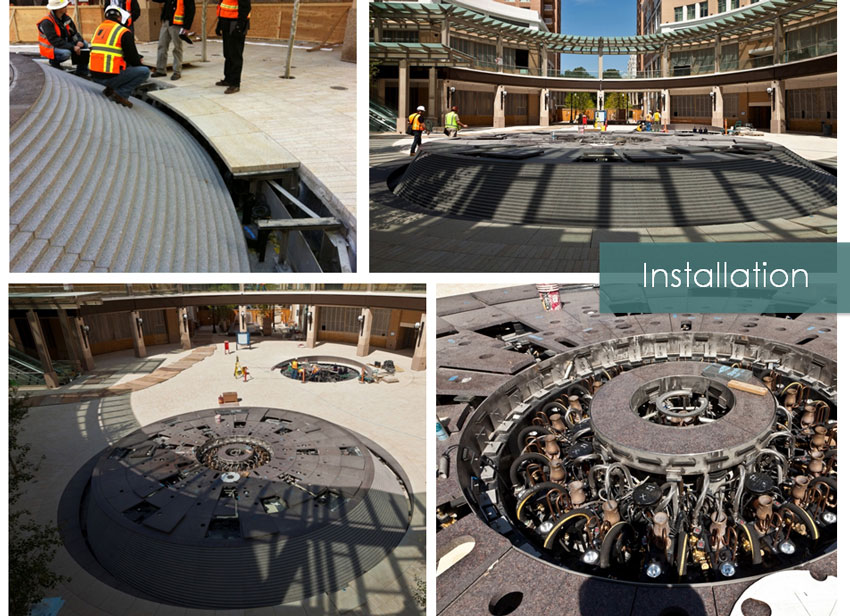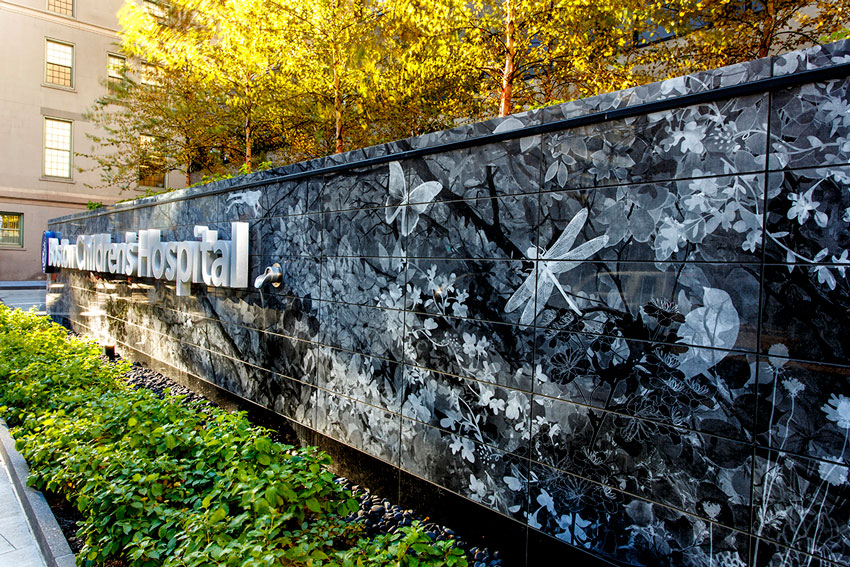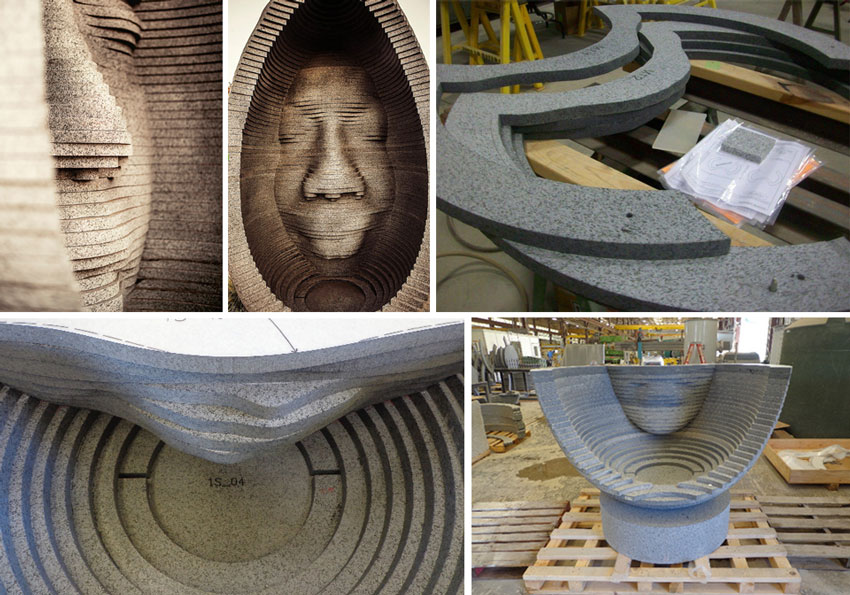Digital Fabrication and Natural Stone
Increased Creativity with CNC Fabrication
City Creek Center, Salt Lake City
Modern technology has made its mark on stone design and fabrication. Today, design teams that take advantage of technology are experiencing increased freedom in design and control of the design concept from development through fabrication. What’s more, improvements in quality control and greater accuracy of the stone’s shaping and final fit and finish are possible.
These high-tech fabrication techniques, which include 3-D modeling, sandblasting, and CNC capabilities, are changing stone fabrication. But while the technology for it is advanced, it’s not cost prohibitive. The process reduces fabrication time, which often makes custom designs more cost efficient for clients.
Architects may feel they have a limited palette of design options when using natural stone. In fact, digital craftsmanship has transformed the natural stone industry. Ross Nadeau, principal, SWA Group, sums up the changes in this industry reflecting on their project in Salt Lake City. “The beauty of technology is that it allows the production of shapes and designs in stones, such as the ones for City Creek Center, that would have been nearly impossible 50 years ago.”
City Creek Center, Salt Lake City’s newest mixed-use development, features no humble task—a replica of the area’s historic City Creek running through it, complete with 300 live trout, more than 600 trees, and hundreds of native plants. In addition, the 23-acre site features numerous fountain experiences constructed of natural stone to enhance the locale, which highlights Utah’s native landscape. There were many man-made materials available and considered for this site, but in the end, the authenticity of the creek was what mattered most to the design team.
For the fountains, the client desired the inclusion of fire and water programmed to music for entertaining City Creek Center patrons. As such, three fountains titled Flutter, Transcend, and Engage were created. Flutter captures attention with dancing fire on sheets of water, spilling out in the shapes of bells in a union of pyrotechnics and nature. Transcend entertains with musically choreographed displays using the elements of fire and water and spewing streams of water upward in playful patterns. Engage invites children to interact with its animations.

Photos courtesy of Coldspring
The design team knew that the fabricator for the fountains at City Creek Center had the technical capabilities, precision with modeling software, and variety of fabrication techniques that would be required to produce the stone fountain’s complex geometries with exact precision.
The design team selected a natural stone fabricator with the modeling software, building information modeling (BIM), and CNC fabrication technology that would be required to produce the stone fountain’s complex geometries with precision. The fountains required extremely tight measurements and exacting precision during fabrication and installation of the stone.
CNC technology enabled the disc to be fabricated with the precision required. In the field, the stone installer painstakingly installed the fountain disc to be level at every point within the thickness of a single piece of paper. This allows for the perfect flow of water to cascade over the entire perimeter evenly and beautifully. The fountain was installed in 2012, and after almost five years, there have been no issues with maintenance or damage on a surface that manipulates both fire and water, demonstrating natural stone’s durability and strength.
Hundreds of critically placed nozzle holes were needed for accurate production of the fountain performances. The stone fabricator meticulously fabricated a total of 176 perfectly positioned holes for water jets and light fixtures and 49 holes for gas-fueled fire nozzles for the dancing fire and water performance for Transcend. The precise stone fabrication eliminated the need for handwork on-site. A LEED Gold-certified project, City Creek Center has played a critical role in Salt Lake City’s sustainable design project to revitalize its downtown.

Photo: © Amesse Photography
The flight of dragonflies, butterflies, and birds that highlight the entry wall for the Boston Children’s Hospital is sandblasted into granite through the application of new stone digital fabrication technology.
Intricate Digital Stone Art Entry Wall
Boston Children’s Hospital
When a project’s design calls for images to be etched into stone, high-tech sandblasting capabilities bring the artist’s vision to life. Such was the case with the granite entrance to Boston Children’s Hospital, where an intricate dot matrix stenciling and sandblast process transferred the artist’s images to polished gray-black stone When guests and visitors approach the entrance of the Boston Children’s Hospital, they are greeted by a hide-and-seek style natural stone wall. The stone provides a backdrop for the intricate design of animals and foliage, which the project’s architect and designer calls “Playful Nature in the City.”
The design team knew that the stone chosen for the 1,200-square-foot structure would have to provide needed contrast and act as a suitable canvas for the project’s engraved art. Black granite was a natural choice and different finishes on this material allows light to dramatically change its appearance without using another stone. The stone selection was an integral part of the design process, as the architect wanted to integrate natural, durable materials into the design of an entry wall exposed to the harsh Boston climate.
The team challenged the fabricator with the task of creating a permanent structural wall surface that was developed from a digitally designed and complicated outdoor sculpture. An intricate dot matrix stenciling and sandblasting process was used to get the graphics onto the face of the polished stone. The light portions of the image are recessed slightly by sandblasting and a white color enhancement applied to the stone to give the images dimension.
The art files were provided to the stone supplier and fabricator in a vector format, which allowed them to be converted to a mask that was then applied to the stone and sandblasted. A great deal of coordination was required to ensure that the artwork looked exactly as the architect intended. Once the artwork was perfected, the rest was up to the craftsman in the fabricator’s facility. With more than 200 pieces of granite and unique images on each piece, the craftsman had to lay out and line up each adjacent piece to ensure that the full image flowed across the entire block.
The sheer size of the 102-foot-long by 7-feet-high wall complicated the scope of this project. The stencil was applied in sections both horizontally and vertically. The installation included 231 facing pieces in the main wall, 14 facing pieces on the return wall, and 35 coping/cap stones for a total equaling 280 pattern pieces. The stone fabricator was required to assure each section was scaled correctly and that the steps to create the halftone pattern were identical on each section to make sure that the final graphics matched. Long-term maintenance of the black granite is minimal, and the art is expected to stand the test of time, delighting visitors for many years to come.

Photos courtesy of Makena Hunt and Coldspring
The faces of individuals from the Los Angeles community are a feature of this modern roundabout. The artist provided detailed drawings that required pieces to be assembled precisely to form the egg sculptures.









